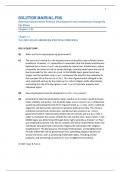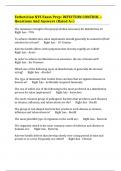1
Solution Manual for
American Government Political Development and Institutional Change By
Cal Jillson
Chapter 1-21
M
Chapter 1
ED
THE ORIGINS OF AMERICAN POLITICAL PRINCIPLES
FOCUS QUESTIONS
Q1 What are the broad purposes of government?
C
A1 The ancients believed the role of government and politics was to foster human
excellence. However, it is imperative to remember that the Greeks and Romans
O
believed the virtuous should rule according to natural law. Furthermore, values
of equality and order would be served through a society based upon the rule of
law to provide for the common good. In the Middle Ages, government was
N
largely used to facilitate religion and maintained the need for the individual to
live a proper life in the service of God. The role of government changed in the
N
early sixteenth century by downplaying the role of religion while alternatively
promoting the role of limited government to protect private property and
individual rights.
O
Q2 How should government be designed to achieve its purposes?
IS
A2 According to Plato the philosopher-king’s wisdom and intellect would promote
order, stability and justice. Yet, Aristotle takes a more realistic view of Athenian
society by advocating the best form of government as a polity, which combined
oligarchic and democratic elements to produce political stability. The Romans
SE
combined monarchical, aristocratic, and democratic principles as a mixed
government within representative bodies like the Senate and the Assembly in
order to champion the causes of both the rich and the poor. Government in the
Middle Ages was determined through divine right, whereby a monarch or Pope
was ordained by God to rule. Hence, wisdom and virtue rested within these few
U
individuals who governed to promote religious life and protect the religious
establishment. The Renaissance, Protestant Reformation, and Enlightenment
Periods shifted the role of government from upholding religious doctrine to
R
secular concerns, such as protecting inalienable rights, including private
property, and promoting commerce. In turn, Enlightenment political
© 2023 Taylor & Francis
, 2
philosophers largely appealed to individualism and not religious hierarchy as a
means to provide order and stability in which individuals could flourish.
Q3 What lessons about government did colonial Americans draw from the history of
ancient Greece and Rome?
M
A3 Plato was suspicious of democracy’s rule of the many because good government
would decay into mob rule. Hence, the passions of the masses needed to be
ED
quelled by more aristocratic elements. With this problem in mind, the Framers of
the U.S. Constitution referenced the institutional design of the Roman republic
adhered to the tradition of mixed government initially expounded by Aristotle
and the Romans. This was maintained in the indirect selection of both the Senate
and the presidency within the Constitution. Aristotle also advocated mixing
aristocratic and democratic elements in a governing structure called a polity. In
C
effect, this governmental design allowed the few and the many to participate in
the politics providing an orderly society where the poor should be able to select
government officials who were held accountable. This was also made manifest in
O
the Constitution with its aristocratic-like Senate and the more democratic House
of Representatives. Thus the American republic’s Constitution established
institutional powers to govern according to the rule of law. While the Framers
N
rejected the religious hierarchy of the Middle Ages, they appealed to inalienable
rights endowed upon every individual by God, per the writings of John Locke, in
N
which a just government and society could not be impeded.
Q4 What circumstances led Europeans to leave their homelands to settle in America?
O
A4 Individuals immigrated to the colonies to escape religious persecution and civil
unrest after the English Civil War and to pursue social and economic
IS
opportunities. Colonists enjoyed a vast array of natural resources and a large
geographical area where freedom of religion and economic opportunity
flourished. Also, their heterogeneous social composition as well as continual
promotion of ideals, such as equality and tolerance, tended to promote political
SE
freedom at the same time that social expansion of the population was occurring.
Q5 What did democracy mean to our colonial ancestors, and did they approve it?
A5 The colonists were skeptical of democracy and viewed this type of governing
U
authority as mob rule. Society was largely seen as segmented into those who
should rule and those who should not. In fact, the Founders believed that the
elite (well-educated, land owners) should occupy positions of leadership. Thus,
R
an aristocratic element within government was necessary to protect against the
threat of mob rule historically associated with democracy. Fundamentally, the
idea of republicanism was promoted as an ideal at a higher level than
democracy. This was made most manifest in the tendency to prefer mixed
© 2023 Taylor & Francis
, 3
constitutional schemes over single-body regimes, such as monarchies,
aristocracies, and democracies. It was in this respect that our colonial ancestors
were both innovative and critical of extant governmental forms yet
simultaneously wedded to the past, especially the Greco-Roman Ancients.
M
CHAPTER OUTLINE
I. A Tradition to Draw From
ED
History and experience provided lessons upon which the Founders referenced in
designing American political institutions.
A. The Ancients: Who Rules and for What Purpose?
The philosophy of Plato and Aristotle was concerned with structuring a
society, known as a city-state, and based upon human nature: Speech and
reason as the fundamental characteristics of humans. Thus, the political
C
community or polis is designed according to the virtues and abilities of its
inhabitants.
1. The Greeks: Monarchy, Aristocracy, Democracy
O
a. According to Aristotle, the purpose of politics is to create an order
that fosters human excellence. Plato’s leader was the philosopher
king. Since Plato doubted the reality of this king, he concluded
N
that good government would be uncommon and short lived.
Plato and particularly Aristotle identified three forms of
N
government:
1) Monarchy—rule by one leader
2) Aristocracy—rule by a few good men
O
3) Democracy—rule by the many
b. Aristotle also theorized that governments would decay. Thus,
monarchy decays into tyranny through despotic actions of a single
IS
ruler. Second, aristocracy decays into oligarchy whereby the few
rule to advance their self-interests contrary to the common good.
Finally, democracy decays into mob rule as the masses rule
according to their passions.
SE
c. Aristotle’s additional contribution: Political order based on reality
1) Aristotle’s contribution was pragmatic by addressing the
needs of the wealthy and the masses within a society to
form a mixed government.
2) He believed that oligarchy and democracy are the most
U
common regimes. Therefore, the best elements of each
might be combined and made into a good, workable, and
stable government. He called this form “polity.”
R
2. The Romans: Republicanism and Mixed Government
a. The Romans, notably Polybius and Cicero, believed that
government’s institutional structure should arbitrate power
between rich and poor. Accordingly, this order was a republic or
© 2023 Taylor & Francis
, 4
mixed state in which monarchical, aristocratic, and democratic
elements are represented.
b. Polybius asserted that this mixed government would promote
stability via a strong executive while also providing a legislative
branch whereby the few (wealthy) and many (poor) could
M
participate in the political process.
c. Cicero appealed to natural law, the necessity of rule of law, and
the virtues of liberty, equality, and the informed consent of the
ED
individual to provide stability, order, and freedom.
d. Cicero’s impact upon the Framers is seen with the concepts of
limited government, separation of powers, and checks and
balances. The Founders, specifically James Madison, reflected
upon the ancient philosopher’s beliefs concerning the roles,
institutions, and mechanisms of politics. However, the task at
C
hand for the Framers of the U.S. Constitution was to design a
government balancing order and freedom to the end of providing
a just government that may be sustained over an extended period
O
of time.
B. The Middle Ages: The Secular Serves the State
The Christian view of political life maintained that the highest goal of man is
N
salvation and eternity, which are achieved by serving God. This view of
political life was proposed by St. Augustine and St. Thomas Aquinas who
N
advocated that both ruler and ruled should conduct themselves in the
political realm as in their personal life through a devotion to God.
1. This had political implications. To achieve salvation the political order
O
was organized to support religious beliefs, values, and expectations.
Thus, religious institutions were active in political matters.
a. Order was needed to allow religion to prosper in peace.
IS
b. Rule by one or a few (e.g. the Pope or king)
c. Religious order assured obedience to authority
d. Power would flow down
e. The many would follow: Obedience would flow up from the
SE
masses
f. Religious values (moderation, tolerance, and faith) would
promote stability and peace
2. Accordingly, hierarchy was the best form of social and political
organization.
U
3. These conditions led to the formation of a stable and peaceful
community.
4. The emphasis placed on religion in the Middle Ages negatively
R
influenced the Framers. The Founders believed that politics and religion
should be separate.
© 2023 Taylor & Francis





